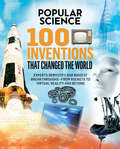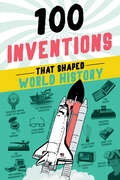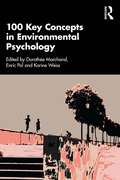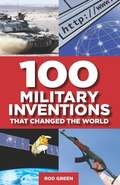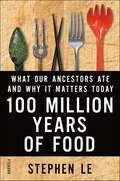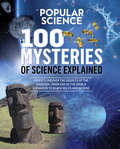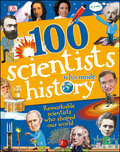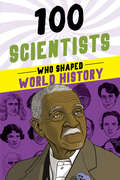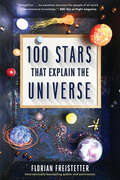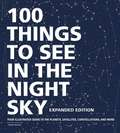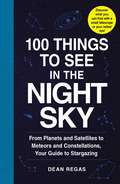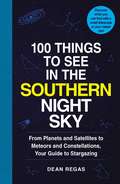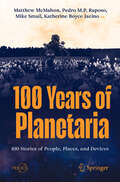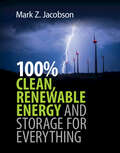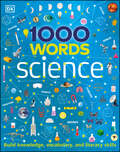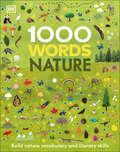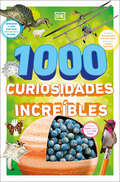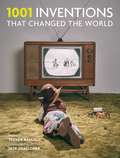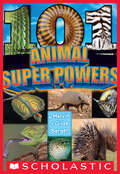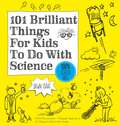- Table View
- List View
100 Inventions That Changed the World (Popular Science)
by The Editors of Popular ScienceFrom safety pins to steam engines to cell phones, the stories behind innovations that have transformed everyday lives. We take thousands of inventions for granted, using them daily and enjoying their benefits. But how much do we really know about their origins and development? This absorbing new book tells the stories behind the inventions that have changed the world, with details about: Convenience items, such as safety pins, toothbrushes, and bifocals Weapons of war, including explosives, gunpowder, and shrapnel shells Industrial advances, such as the steam engine and the power loom for weaving Transportation advances, including the airplane, the diesel engine, the automobile, and the air-inflated rubber tire Electronic marvels, including color television, the microprocessor, the personal computer, the compact disc, and the cell phone Medical advances, from antiseptic surgery to the electron microscope...and much more You&’ll also learn more about many inventors and pioneers of science and technology—including Eli Whitney, James Watt, Benjamin Franklin, Henry Bessemer, Thomas Edison, J.B. Dunlop, the Wright Brothers, Werner von Braun, Jonas Salk, J. Robert Oppenheimer, and others.
100 Inventions That Shaped World History (100 Series)
by Bill YenneFascinating stories behind 100 of the most important inventions in history, for kids 8 and upThis fast-paced journey through the most vital developments and inventions of all time features:100 easy-to-read stories: Find out how each invention came to be!Illustrations: Each entry includes an illustrated image of the invention to help bring history to life!A timeline, trivia questions, project ideas and more: Boost your learning and test your knowledge with fun activities and resources!From the compass to the printing press, television to virtual reality, readers will learn about 100 of the most important inventions, advancements, and discoveries that have changed the course of human history. Organized chronologically, this fast-paced journey through the history of technology will help kids understand how their favorite modern conveniences came to be.
100 Key Concepts in Environmental Psychology
by Dorothée MarchandThis accessible book defines 100 key concepts, ideas and processes in Environmental Psychology to provide an introductory reference work that brings together research and theory in a bite-size format. With contributions from leading figures within Environmental Psychology, each concept is clearly defined and explained within the context of issues around the environment, sustainability, climate change, nature and architecture. This book considers the involvement of psychological, physiological and social processes to understand the mechanisms that explain and contribute to the evolution of behavior and attitudes that relate to our relationship with the environment. Concepts covered include biodiversity, eco-anxiety, place identity, sustainable behaviour, climate justice and environmental attitudes. By integrating ideas from different disciplinary orientations in the field of Environmental Psychology, this book allows for a better understanding of the processes related to the individual-environment relationship, as well as the applications that they allow for in various fields of intervention. This is essential reading for students and researchers in Environmental Psychology, Sustainability Studies, Architecture and Built Environment Studies and related fields.
100 Military Inventions that Changed the World: That Changed The World
by Philip RussellNothing ensures the rapid development of new technology like the involvement of the military. From the trebuchet and the cannon to the tank and the ballistic missile, military research programmes have produced the most devastating weapons imaginable, but military masterminds are responsible for a number of surprises along the way as well.Radar, walkie-talkies and the jet engine are more obvious examples of military inventions that are now in everyday use around the world, but there are plenty of items with which all of us come into contact on a daily basis that have been developed from military technology. Rod Green describes how the microwave oven in your kitchen, the sat-nav in your car or the Internet that you use every day all owe their existence to the military as he takes us on a highly entertaining voyage of discovery through the world of military inventions ancient and modern.
100 Military Inventions that Changed the World: That Changed The World
by Rod GreenNothing ensures the rapid development of new technology like the involvement of the military. <P><P>From the trebuchet and the cannon to the tank and the ballistic missile, military research programmes have produced the most devastating weapons imaginable, but military masterminds are responsible for a number of surprises along the way as well. Radar, walkie-talkies and the jet engine are more obvious examples of military inventions that are now in everyday use around the world, but there are plenty of items with which all of us come into contact on a daily basis that have been developed from military technology.<P>Rod Green describes how the microwave oven in your kitchen, the sat-nav in your car or the Internet that you use every day all owe their existence to the military as he takes us on a highly entertaining voyage of discovery through the world of military inventions ancient and modern.
100 Million Years of Food: What Our Ancestors Ate and Why It Matters Today
by Stephen LeA fascinating tour through the evolution of the human diet and how we can improve our health by understanding our complicated history with food.There are few areas of modern life that are burdened by as much information and advice, often contradictory, as our diet and health: eat a lot of meat, eat no meat; whole grains are healthy, whole grains are a disaster; eat everything in moderation; eat only certain foods--and on and on. In 100 Million Years of Food, biological anthropologist Stephen Le explains how cuisines of different cultures are a result of centuries of evolution, finely tuned to our biology and surroundings.Today many cultures have strayed from their ancestral diets, relying instead on mass-produced food often made with chemicals that may be contributing to a rise in so-called Western diseases, such as cancer, heart disease, and obesity.
100 Mysteries of Science Explained (Popular Science)
by The Editors of Popular ScienceAnswers on subjects from dark matter to disappearing bees, from the magazine that&’s been enlightening and entertaining Americans for nearly 150 years. What happened to the Neanderthals? When is the next Ice Age due? Why do we hiccup? From end-of-the-world scenarios to what goes on within our own brains and bodies, the experts at Popular Science magazine uncover the secrets of the universe and answer 100 of science&’s most mysterious questions. With sections on Physical Matter and Forces, Space, Human Body, Earth, Other Life-Forms, and Human Triumphs and Troubles, 100 Mysteries of Science Explained takes you into the fascinating world of black holes, time travel, DNA, earthquakes, and much more.
100 Scientists Who Made History (DK 100 Things That Made History)
by Andrea MillsFrom brainy biologists and clever chemists to magnificent mathematicians and phenomenal physicists. Discover 100 remarkable scientists who shaped our world.Containing a universe of knowledge, this amazing kids' educational book tells the story of the extraordinary people who revolutionized our understanding of the world. A stunning way for children to meet science's most important people.Read through information-packed mini-biographies of 100 brilliant scientists and innovators who have shaped our society and how we see the world around us. A perfect "everything you want to know in one place" about the history of science for children aged 8-12.Readers learn about discoveries that laid the groundwork for some of the most impressive innovations in history. Biologists, chemists, physicists, doctors, coders, and astronauts are all featured including Hippocrates, Da Vinci, Alan Turing, Stephen Hawking, Neil deGrasse Tyson, and more. An attractive and engaging kids book that may inspire the next Einstein or Curie! Made for those always curious children and those who need encouragement to aspire to greatness and see the marvels of science. Put children inside the minds of scientific heroes through clever speech bubbles alongside portraits with first-person fun facts about their lives. It's a cool way to personalize these incredible people and engage children while giving them a solid base in science. Did you know that Marie Curie's notebooks are still radioactive? They're too dangerous to touch and even glow! And Louis Pasteur, who furthered the development of vaccinations and more, liked to paint in his spare time? Who knew!Learn About The Minds Who Shaped The World!Dive into the world of theories and experiments, reactions, and equations, as we meet the figures who have helped us understand our universe and our place in it. Find out why Copernicus shook the world, what elements Marie Curie discovered, and how Franklin, Crick, and Watson unlocked the secrets of our DNA. It's divided into Pioneers, Biologists, Chemists, Physicists, and Innovators, whose innovations have changed the world and continue to change it now. Discover amazing facts about the world and the people behind some of humanity's most impressive advancements. Some of the amazing trailblazers you'll meet:- Alan Turing- Marie Curie- Barbara McClintock- Leonardo da Vinci- And so many more! This fabulous title is one of five children's books in the 100 In History series. Add 100 Women Who Made History, 100 People Who Made History, 100 Events That Made History, and 100 Inventions That Made History to your bookshelf and learn more about the significant people, events, and inventions that shaped the world we live in today.
100 Scientists Who Shaped World History (100 Series)
by John Hudson TinerLearn all about the fascinating lives and tremendous impact of 100 extraordinary scientists from all over the world with this fact-filled biography collection for kidsEducational and engaging, 100 Scientists Who Shaped World History features:Simple, easy-to-read text that has been freshly updatedIllustrated portraits of each figureFascinating facts about famous and lesser-known scientistsA timeline, trivia questions, project ideas and more!From Pythagorus to Isaac Newton, Louis Pasteur to Marie Curie, Rosalind Franklin to Stephen Hawking and many more, readers will be introduced to the lives and accomplishments of the greatest scientists throughout history. Organized chronologically, 100 Scientists Who Shaped World History offers a look at the amazing discoveries and advancements made by these figures and shows how scientific contributions have helped guide humanity for thousands of years.
100 Stars That Explain the Universe
by Florian FreistetterVisit one hundred extraordinary stars that unveil the mysteries of the universe Our own Sun—a source of awe, myth, and mystery for untold generations of sky-gazers—is just one of roughly two hundred billion trillion stars. Together, they’re a window into the profoundest questions in physics—overturning, again and again, how we understand light, matter, time, and existence itself. Florian Freistetter explains all this and more, in brief, easy-to-read profiles of the hundred most history-making stars, inviting readers to gaze into the past and future of the universe alongside a stellar cast of scientists— from Annie Jump Cannon, who revolutionized how we classify the stars, to Dorrit Hoffleit, who first counted them. Enjoy your journey through the cosmos . . . GRB 080319B, the farthest we’ve seen into space with the naked eye V1364 CYGNI, pivotal in the discovery of dark matter 72 Tauri, definitive evidence for Einstein’s theory of relativity Algol, called the Demon Star for its mysterious blinking—and many more! Publisher’s note: 100 Stars That Explain the Universe was previously published in hardcover as The Story of the Universe in 100 Stars.
100 Things to See in the Night Sky, Expanded Edition: Your Illustrated Guide to the Planets, Satellites, Constellations, and More
by Dean RegasDiscover the amazing wonders of the night sky with this expanded edition to 100 Things to See in the Night Sky, perfect for every amateur stargazer and armchair astronomer! Keep your feet on the ground and experience the night sky to the fullest by exploring planets, satellites, and constellations with this all-inclusive reference guide to space. 100 Things to See in the Night Sky, Expanded Edition is full of information on the many amazing things you can see with a telescope, or just your naked eye! From shooting stars to constellations and planets to satellites, this book gives you a clear picture of what you can see on any given night. Learn about the celestial bodies that have captured people&’s imaginations for centuries, with specific facts alongside traditional myths and beautifully illustrated photographs and star charts that will help you know where to look for the best view. With this illuminating guide, you&’ll enjoy hours of stargazing, whether you&’re travelling, camping, sitting in your back yard, or simply flipping through the beautiful images in this book.
100 Things to See in the Night Sky: From Planets and Satellites to Meteors and Constellations, Your Guide to Stargazing (100 Things to See)
by Dean RegasA handy field guide for the best stargazing experience whether in your own back yard, camping, or travelling—including information showing you which planets, constellations, stars, and manmade objects you can see with a telescope, or just your naked eye!The night sky is full of amazing things to see—from shooting stars and constellations to planets and satellites—but it can be hard to tell what you’re seeing, or where to look for the best view. 100 Things to See in the Night Sky gives you a clear picture of what you can see on any given night, either using a small telescope, or just your naked eye. Each object is presented as a separate entry, with background information on the makeup, appearance, and history of the object, along with easy-to-follow instructions on how to find it. For astronomy and space fans of all ages, this guide helps you explore the galaxy and see the stars—while keeping your feet on the ground.
100 Things to See in the Southern Night Sky: From Planets and Satellites to Meteors and Constellations, Your Guide to Stargazing (100 Things to See)
by Dean RegasA handy field guide for the optimum stargazing experience, whether you’re travelling, camping, or in your own backyard!The night sky is full of amazing things to see, from shooting stars and constellations, to planets and satellites, but it can be hard to tell what you’re seeing, or where to look for the best view. 100 Things to See in the Southern Night Sky lets you know what you can expect to see on any given night, whether you’re using a small telescope, or just your naked eye. 100 Things to See in the Southern Night Sky—especially for those south of the equator—includes background information on the makeup, appearance, and history of each celestial object, along with easy-to-follow instructions on the best way to catch a glimpse of these cosmic glories. With this helpful guide you’ll have the world on a string—or more precisely, the sky in your hands.
100 Years of Fundamental Theoretical Physics in the Palm of Your Hand: Integrated Technical Treatment
by E. B. ManoukianThis book aims to integrate, in a pedagogical and technical manner, with detailed derivations, all essential principles of fundamental theoretical physics as developed over the past 100 years. It covers:Quantum physics and Stability Problems in the Quantum World, Minkowski Spacetime PhysicsParticle Classifications and Underlying Symmetries, Symmetry Violations, Quantum Field Theory of Particle Interactions, Higgs Field Physics, Supersymmetry: A Theory with Mathematical BeautySuperstrings, Gravity and Supergravity, General Relativity Predictions, including Frame Dragging, Intricacies of Black Hole Physics, Perturbative and Non-perturbative Quantum GravityIntricacies of Modern Cosmology, including Inflation and Power Spectrum If you are in the process of learning, or are lecturing on, any of the subjects above, then this is your book - irrespective of your specialty.With over-specialization and no time to master all the fields given above, students, and perhaps many physicists, may find it difficult to keep up with all the exciting developments going on, and are even less familiar with their underlying technicalities: e.g. they might have heard that the Universe is 13.8 billion years old, but have no idea on how this number is actually computed.This unique book will be of great value to graduate students, instructors and researchers interested in the intricacies and derivations of the many aspects of modern fundamental theoretical physics. And, although a graduate level book, some chapters may also be suitable for advanced undergraduates in their final year.
100 Years of Planetaria: 100 Stories of People, Places, and Devices (Springer Praxis Books)
by Matthew McMahon Pedro M. P. Raposo Mike Smail Katherine Boyce-JacinoThis book marks the centenary of the remarkable invention of an opto-mechanical planetarium projector, the Zeiss Mk I. In May 1925, the first public planetarium opened at the Deutsches Museum in Munich. In the ensuing decades, this invention spread all over the world, becoming an integral part of modern life. The book presents a global narrative of the modern planetarium and its history through a selection of 100 objects and their stories. Written by a varied international group of contributors including planetarium professionals, scientists, historians, and other experts, these object stories highlight major developments in planetaria as they relate to advances in astronomy and space science as well as changes in society and culture at large. The objects featured in this book show how planetaria gained a central place in modern life at the intersection between science, education, art, and entertainment. They also connect the reader with the diverse people whohave made the modern planetarium a reality and continue to pave the way for its future - be they planetarium staff, scientists, architects, artists, engineers, educators, or planetarium visitors.
100 Years of Superconductivity
by Horst Rogalla and Peter H. KesEven a hundred years after its discovery, superconductivity continues to bring us new surprises, from superconducting magnets used in MRI to quantum detectors in electronics. 100 Years of Superconductivity presents a comprehensive collection of topics on nearly all the subdisciplines of superconductivity. Tracing the historical developments in supe
100% Clean, Renewable Energy and Storage for Everything
by Mark Z JacobsonNumerous laws – including the Green New Deal – have been proposed or passed in cities, states, and countries to transition from fossil fuels to 100% clean, renewable energy in order to address climate change, air pollution, and energy insecurity. This textbook lays out the science, technology, economics, policy, and social aspects of such transitions. It discusses the renewable electricity and heat generating technologies needed; the electricity, heat, cold, and hydrogen storage technologies required; how to keep the electric power grid stable; and how to address non-energy sources of emissions. It discusses the history of the 100% Movement, which evolved from a collaboration among scientists, cultural leaders, business people, and community leaders. Finally, it discusses current progress in transitioning to 100% renewables, and the new policies needed to complete the transition. Online course supplements include lecture slides, answers to the end-of-chapter student exercises, and a list of extra resources.
1000 Fragen aus Genetik, Biochemie, Zellbiologie und Mikrobiologie
by Olaf WernerDiese Studienhilfe dient Ihrer Selbstkontrolle und damit der Vorbereitung auf Prüfungen. Sie bietet Ihnen die Möglichkeit, sich mit den vielfältigen Fragen in Ruhe zu Hause auseinanderzusetzen und Ihr Wissen eigenständig zu überprüfen; oder Sie nutzen die Fragen als Anregungen, wenn Sie sich in Lerngruppen gegenseitig abfragen. Die 1000 Fragen sollen Ihnen helfen, sich in Genetik/Molekularbiologie, Biochemie, Zellbiologie und Mikrobiologie zu vertiefen, und sind nach den vier Fachgebieten geordnet. Sie finden zu den wichtigsten Themen Multiple-Choice-Fragen mit in der Regel kurzen Antworten, die Sie am Ende des Buches nachschlagen können. Die Fragen sind bewusst unterschiedlicher Natur und in unterschiedlichen Schwierigkeitsgraden. Wissensfragen erfordern ein Faktenwissen, das Sie sich in der Regel mit dem Durcharbeiten von Vorlesungen und Lehrbüchern problemlos aneignen werden. Daneben finden Sie Verständnisfragen, deren Beantwortung voraussetzt, dass Sie die Zusammenhänge in der Biologie insgesamt oder innerhalb biologischer Einzelthemen verstanden haben. Mit den 1000 Fragen sollten Sie auf ideale Weise Ihr Wissen überprüfen und Ihre Lücken erkennen können.
1000 Fragen aus Zoologie und Botanik
by Olaf WernerDiese Studienhilfe dient Ihrer Selbstkontrolle und damit der Vorbereitung auf Prüfungen. Sie bietet Ihnen die Möglichkeit, sich mit den vielfältigen Fragen in Ruhe zu Hause auseinanderzusetzen und Ihr Wissen eigenständig zu überprüfen; oder Sie nutzen die Fragen als Anregungen, wenn Sie sich in Lerngruppen gegenseitig abfragen. Zusätzlich zu den rein zoologischen und botanischen Fragen sind außerdem einige aus den verwandten Bereichen Ökologie und Evolution enthalten, um den Prüfungsstoff umfassender abzudecken. Die 1000 Fragen sollen Ihnen helfen, sich in diesen vier Themengebieten zu vertiefen und sind nach den Fachgebieten geordnet. Sie finden zu den wichtigsten Themen Multiple-Choice-Fragen mit in der Regel kurzen Antworten, die Sie am Ende des Buches nachschlagen können. Die Fragen sind bewusst unterschiedlicher Natur und in unterschiedlichen Schwierigkeitsgraden. Wissensfragen erfordern ein Faktenwissen, das Sie sich in der Regel mit dem Durcharbeiten von Vorlesungen und Lehrbüchern problemlos aneignen werden. Daneben finden Sie Verständnisfragen, deren Beantwortung voraussetzt, dass Sie die Zusammenhänge in der Biologie insgesamt oder innerhalb biologischer Einzelthemen verstanden haben. Mit den 1000 Fragen sollten Sie auf ideale Weise Ihr Wissen überprüfen und Ihre Lücken erkennen können.
1000 Words: Build Knowledge, Vocabulary, and Literacy Skills (Vocabulary Builders)
by DKIntroduce key scientific concepts to your child and encourage early reading, writing and vocabulary skillsDid you know that science is all around us, even on the playground? Open the pages of this illustrated picture and word book for young readers to discover the wonders of Science in 1000 words.This fascinating STEM education book for kids is packed with bright, detailed illustrationsand easy-to-read terms. Every picture-packed page is full of scientific concepts such as sound, light, senses, and machines, with words for each image. It&’s perfect for preschoolers or those learning English as a second language. This must-have reference book will broaden children&’s vocabulary and strengthen their early reading and writing skills. Full of fun facts and stats, leading educational experts have carefully selected each topic with questions that stimulate thinking, talking, and early science skills. This vocabulary book also includes lots of useful nouns, plus some interesting adjectives, and common verbs.Feed your child&’s curiosity and help them shape their language, science, and literacy skills. This will foster a love for science and critical thinking to inspire kids to want to know more about how the world around them works.Encourage Early Science, Vocabulary and Literacy Skills Discover a different and exciting STEM topic on every page of this science book for kids! Delve into the key scientific concepts from sound and light to plants and animals. It&’s the perfect gift for children who are curious about science and keep asking the how and why questions!Use picture-and-word association to learn about STEM topics like: • Seasons, the weather, and why things get hot and cold • Machines, materials, and junk • Being at the doctor and inside the human body • Vehicles, transport, the moon landing, and much much more
1000 Words: Build Nature Vocabulary and Literacy Skills (Vocabulary Builders)
by Jules PottleBuild up a vocabulary and interest in Earth science, wildlife and the environment!Expand your English knowledge and improve your reading comprehension and grammar skills through this natural science book. Learn about plants, animals, natural landscapes, and the oceans — and the human impact on the planet.This picture book helps children and EFL learners build up a vocabulary of 1,000 nature words. Inside, you&’ll find: • A comprehensive range of nature topics — from nature activities, our planet, different habitats and weather to the kingdoms of living things, plant and animal life cycles, and protecting our world and its resources • A mix of real-life photos that build knowledge of the world and imaginative artwork that gives context for the words, and add fun and humor • Layout and vocabulary choices for pre-readers, beginner readers and English language learners Written by award-winning science teacher Jules Pottle, this Earth science book introduces important concepts about the Earth and animals! This educational book broadens students&’ vocabulary and strengthens their early reading skills. Every picture-packed page is full of fascinating things like the parts of a plant, how animals communicate, habitats and what we can do to help protect nature. Topics include questions that encourage learners to find objects on the page or that stimulate thinking, talking and reading comprehension skills. The words include lots of useful nouns, plus some interesting adjectives and common verbs related to wildlife and the planet. 1000 Words: Nature clearly labels each picture, which encourages picture-and-word association and helps early reading.The 1000 Words series is a collection of fun and educational picture word books that help develop children&’s and EFL learners&’ language, science and literacy skills. Include 1000 Useful Words and 1000 Words: STEM to your bookcase!
1000 curiosidades increibles (DK 1,000 Amazing Facts)
by DKDescubre miles de datos que aunque parecen increíbles, ¡son 100% ciertos!Si alguien te dice que la Torre Eiffel cabría dentro de una duna de arena del Sáhara, ¿te lo creerías? ¿O que el corazón de una ballena tiene el tamaño de un coche? ¿Sabías que la Luna tiene el mismo tamaño que Australia? ¿Y que en la próxima hora 8000 personas vendrán al mundo?¡Sorprende a tus amigos y familiares con este divertido libro ilustrado repleto de curiosidades!Contiene más de 1000 datos curiosos que no te dejarán indiferente.Escrito de forma clara, con explicaciones entretenidas, formato de pregunta y respuesta e imágenes generadas por ordenador.También incluye estadísticas alucinantes explicadas por medio de gráficos y comparaciones visuales que te ayudarán a entender los datos de forma fácil.Hazte con esta increíble enciclopedia y explora todo aquello que puedas imaginar, desde el microchip más pequeño hasta la galaxia más lejana del universo. Repleto de sorpresas y datos impresionantes, es el regalo perfecto para niños de 9 años o más que quieren conocer el maravilloso mundo que les rodea.-------------------------------Dive into a world of mind-blowing facts that may defy belief, but they are all absolutely true!Can you believe the Eiffel Tower would fit inside a Sahara sand dune? Wow, your friends, and amaze your family with hundreds of new facts in this fun-filled, picture-packed bumper book for children aged 9+. 1,000 Amazing World Facts contains striking images, visual comparisons, and informative diagrams in one unforgettable journey around the world. No subject is left unexplored, from the tiniest microchip to our unimaginably enormous Universe.Celebrate your child's curiosity as they explore:1,000 mind-blowing facts that will be sure to wow family and friends.CGI graphics, fun visual comparisons, and diagrams make stats and facts easy to understand.Science boxes that are illustrated with engaging diagrams to explain information.Did you know that Earth could fit inside Jupiter more than 1,000 times? Or is the blue whale's heart as big as a car? Children will love all these facts and more, presented either with impressive CGI illustrations or eye-popping photography – plus additional boxes feature diagrams that make information easy to understand.
1001 Inventions That Changed the World (1001 Series)
by Jack ChallonerThe history of the world through 1,001 inventions—from prehistoric times to the present day.1001 Inventions That Changed the World is an enthralling guide to the world&’s most important scientific and technological advances. Authoritatively written by a team of historians, scientists, and anthropologists, this book tells the stories behind these innovations, presenting a comprehensive history of the world through invention and discovery. From stone tools and fire at the dawn of humankind to today&’s self-driving cars, inventions have moved society forward at a remarkable pace. This informative volume shows just how much some of the inventions that we take for granted have transformed the world.
101 Animal Superpowers
by Melvin Berger Gilda BergerFind out which creatures in the animal kingdom have the coolest superpowers in this new book in the 101 Animal series!Discover some of the most extraordinary creatures in nature! This book takes a close look at 101 of the coolest tricks and superpowers in the animal kingdom. Find out how these animals' superpowers work and what they use them for--both to hunt and to protect themselves! Organized from A to Z, meet insects, reptiles, mammals, birds, and fish, all that have amazing super-abilities!
101 Brilliant Things For Kids to do With Science
by Dawn IsaacFrom bestselling kids' activity author Dawn Isaac comes this exciting new volume full of creative (and occasionally outrageous) ideas for budding young scientists. Whether your child is crazy about chemistry or bananas about biology (or, let's face it, just likes making a mess), this book is choc-a-block full of experiments and projects that will get kids really excited about science - and all without going anywhere near a TV, tablet or computer screen. Whether they want to Launch a Rocket, Blow a Square Bubble, Discover their own DNA or Build a Balloon Powered Racing Car, there's a whole wealth of fun suggestions to keep kids amused - and you never know, they might even learn something along the way.
